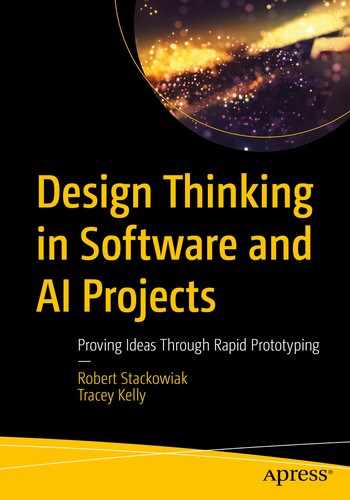Design Thinking in Software and AI Projects
Proving Ideas Through Rapid Prototyping
1st ed.
To Jodie, my partner over these many years, who makes solving life’s problems fun.
—Robert Stackowiak
To Dan, my husband, who shares my consuming passion for user experience design, and my parents who encouraged my love of technology and creativity.
—Tracey Kelly
We, the authors of this book, are on a journey. During much of our careers, we helped organizations define software, analytics, and AI technology footprints that were to be put into place to solve business problems. Some of those clients succeeded in building the solutions, rolling them out, and gaining widespread adoption. Others stumbled. Most often, when failure occurred, it was not due to the technology choices that were made.
Many technology people understand that the success rate of software development projects is not as high as it needs to be. The community has tried to solve this lack of success in various ways over many years. Most recently, there has been an emphasis on development in shorter cycles manned by small teams leveraging reusable services. The limited sprints in a modern DevOps approach can identify bad technology choices and unsuccessful development efforts sooner. However, this approach doesn’t solve the problem of misguided efforts due to bad assumptions about what the business wants or needs.
Both of us spent significant time in recent years in front of business and IT audiences (including executives, managers, frontline workers, and developers/data scientists). When we got them together in the same room, magic began to happen. We were able to mediate discussions that provided a translation between what the business needed and what IT thought they wanted. Project goals became better defined, and success criteria became understood by all.
As we found our way, Design Thinking gained in popularity as a technique to be used in problem identification and solution definition. It was often applied where organizations were seeking to develop innovative processes and products. Today, this approach is taught in many leading universities and is practiced by a variety of consulting companies.
Where software is concerned, Design Thinking is most closely associated with user experience (UX) design of interfaces. However, we have found great value in using the technique to drive a much broader array of software and AI projects in our many client engagements.
As we gathered our own best practices, we researched Design Thinking books and guides that targeted all sorts of design projects. Over time, we’ve adopted a core group of exercises and approaches that we find useful in our workshops that more often (than not) lead to software and AI projects.
This book is primarily focused on these best practices as we describe what Design Thinking is, preparing for a Design Thinking workshop, problem definition, and solution definition in the first four chapters. As we proceed through the workshop content, we apply our favorite methods and tools in a step-by-step fashion. To help you understand the output expected in each exercise, we illustrate sample output we might obtain in defining a supply chain optimization problem and potential solution.
In the remaining chapters, we proceed through software and AI prototype development, production development, and production rollout. We felt it important to show how the development process that follows the workshop is linked and note where we believe it could make sense to reexamine the conclusions and information that we found in the workshop.
We believe that Design Thinking is critical to defining the destination that an organization wants to reach and why it needs to go there. Starting a software development or AI project without this knowledge can result in many wrong turns and possibly lead nowhere. Investing in the time it takes to run a Design Thinking workshop should become part of an organization’s standard operating procedures for any design. But we believe this to be especially true for software and AI projects where the goal is to deliver business value quickly, gain widespread adoption, avoid missteps, and minimize wasted efforts and resources.
We are obviously not the first to write about Design Thinking. Because previous practitioners shared their methodologies and approaches to problem identification and solution definition, we were able to learn from the best and adapt the exercises, tools, and methods into repeatable engagements appropriate to drive software and AI projects. We list many of these sources in the Appendix of this book and encourage you to investigate them as well.
Over the past few years, we worked in Microsoft Technology Centers and with the Microsoft Catalyst team in implementing many of these best practices. As we delivered Design Thinking training within Microsoft, we discovered many other practitioners of this approach within these groups and within Microsoft’s partner community. We would like to thank some of the early proponents of applying this methodology there, including Craig Dillon, Carsten Scheumann, Shawna Flemming, Jennifer Kim, Jason Haggar, April Walker, Beth Malloy, Muge Wood, Charles Drayton, Dave Wentzel, Valerie Bergman, Sumit Wadhwa, Brandon Hancock, Jeff Hall, Daniel Hunter, Ryan McGann, Lafayette Howell, Kate Michel, Kevin Hughes, David Brown, Paul McPherson, Kevin Sharp, Harsh Panwar, Rob Nehrbas, Ruba Hachim, Amir Karim, J.P. DeCuire, Lora Lindsey, Susan Slagle, Sean McGuire, Nini Roed, Chris Han, Rudy Dillenseger, Ryan Hastings, Ovetta Sampson, Howe Gu, Aric Wood, and Thor Schueler.
As we were fine-tuning our techniques, we led workshops involving clients from a variety of industries who faced many different and often unique challenges. Those experiences helped us determine what worked and how to customize engagements for unique circumstances. Our thanks to those clients for enthusiastically taking part as we learned together. Hopefully, many of them continue to use Design Thinking as an approach today within their organizations.
The fine folks at Apress have once again provided us with an excellent writing and publishing experience. As he usually does, Jonathan Gennick, Assistant Editorial Director, helped us improve the book’s original proposal by making excellent suggestions regarding content and guided the book through the approval process there. Jill Balzano, Coordinating Editor, helped us stage content and managed the review process behind the scenes. Having worked with other publishers where turnover is frequent, having these two consistently involved throughout the production of this book (and several others) is sincerely appreciated and speaks to the quality of the publisher.
Robert would like to thank Jodie, his wife of over 40 years. She has grown familiar with the dedicated time that must be spent writing books like this one (since he has been writing books for over 20 years). Her support and patience are truly amazing.
Next, Tracey would like to thank Robert for his friendship and collaborating on this book. Tracey would like to thank her friends Naomi, Rebecca, Wayne, Dennis, Erin, Jason, Mel, and Bri for constantly supporting her diverse creative endeavors no matter how crazy. Tracey deeply thanks and appreciates her mom and dad for always encouraging her to be creative and to invent/make things, to explore the world, to be curious about new technology, and to see failures or mistakes as opportunities to learn and grow.
Tracey would also like to thank Dan Kelly, her husband, who also has a love for thoughtful, well-designed products and services. He works in design as a product manager at Charles Schwab and has a passion for business education. She is deeply thankful for his support. He is truly a model for investing time to deeply understand the problem before jumping to solutions and not reacting. His kindness, wisdom, learner mindset, and integrity make him her favorite person in the world.

works as an independent consultant, advisor, and author. He is a former data and artificial intelligence architect and technology business strategist at the Microsoft Technology Center in Chicago and previously worked in similar roles at Oracle and IBM. He has conducted business discovery workshops, ideation workshops, and technology architecture sessions with many of North America’s most leading-edge companies across a variety of industries and with government agencies. Bob has also spoken at numerous industry conferences internationally, served as a guest instructor at various universities, and is an author of several books. You can follow him on Twitter (@rstackow) and read his articles and posts on LinkedIn.

is the Envisioning Lead with the Catalyst team at Microsoft. She has been leading the Design Thinking training through North America and Europe to help Microsoft technology-focused architects and business leadership transition and transform to customer-centric and business outcome solutions. Tracey is also on the board of the Women’s Technology Coalition and a former Women in Technology Director in Dallas. She leads design workshops and customer strategy sessions and has a long 20-year history of technology and design leadership at Fortune 500 companies to drive innovation.
